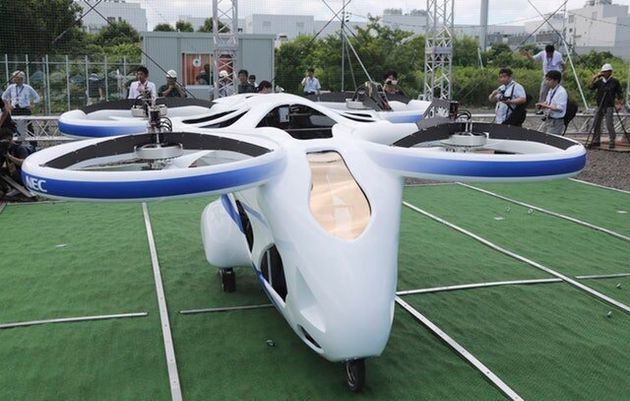
Giving us major Back to the Future vibes, Japanese electronics firm NEC has unveiled a flying car which hovered steadily in the air for about a minute during its first test flight in Tokyo.
The large drone-like machine with four propellers hovered as high as 10ft at the event, which was held in a gigantic cage as a safety precaution in the Tokyo suburb of Abiko.
Preparations for the test flight – which included repeated checks on the machine and warnings to all reporters to wear helmets – took up more time than the two brief demonstrations of the car.
The Japanese government is behind the prototype, with a goal to have people zipping around in the flying cars by the 2030s.
[Read More: Uber To Launch Flying Taxis]

Often called EVtol, for “electric vertical takeoff and landing” aircraft, a flying car is defined as an aircraft that is electric, or hybrid electric, with driverless capabilities, which can land and take off vertically.
The latest prototypes for flying cars – drones big enough to hold humans – are designed to better helicopters, which can be expensive to maintain, noisy to fly and require trained pilots. Flying cars also are being touted as useful machines for disaster relief.
Part of the Japanese government-backed endeavour is a huge test course to be built in an area devastated by the 2011 tsunami and nuclear disasters in Fukushima in north-eastern Japan.
Mie, a prefecture in central Japan frequently used as a resort area by Hollywood celebrities, also hopes to use the flying cars to connect its various islands.
An earlier flying car tested by Japanese startup Cartivator crashed quickly in a 2017 demonstration. Cartivator chief executive Tomohiro Fukuzawa, who was at Monday’s demonstration, said its machines could now stay airborne for longer.
NEC is among the more than 80 sponsor companies for Cartivator’s flying car, which also include Toyota group companies and video game company Bandai Namco Holdings.
While the goal of flying cars is to deliver a seamless transition from driving to flight, huge hurdles remain such as battery life, the need for regulations, and safety concerns.
NEC officials said its flying car was designed to make deliveries on unmanned flights, but that the company’s technology could be used in other operations such as space travel and cyber security.
US ride-sharing and transportation network Uber is planning demonstrator flights in 2020 and commercial operations in 2023, and has chosen Dallas, Los Angeles and Melbourne as the first cities to offer what it calls Uber Air flights.
But Japanese officials say Japan has a good chance of emerging as a world leader if the government and the private sector work closely together.


